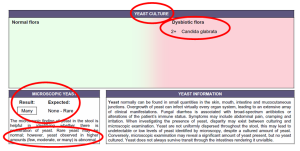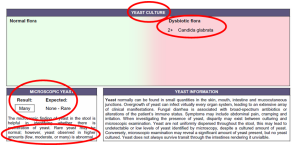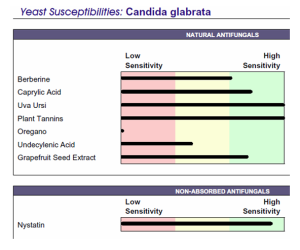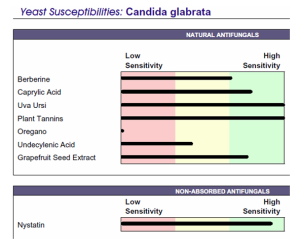In my last article I talked about the symptoms of a yeast infection. In this article I’ll dive in a little deeper and talk about the underlying triggers for yeast infections and how to get properly tested for yeast infection.
You see, Functional Medicine is always about finding the cause. I like to say: Find the cause. Fix the cause. Feel normal again.
And, great Functional Medicine Docs are always asking the question ‘why’.
Why is yeast present?
Why does this patient have Candida?
(By the way, ‘Candida’ is often used interchangeably with the word ‘yeast’. Candida is actually a subset of yeast that are common in the human microbiome.)
(To make it even more confusing, ‘fungus’ is also often used interchangeably with the word ‘yeast’ as well.)
Candida is always opportunistic.
When I find a yeast/Candida infection I always ask myself ‘why’ – where did this infection come from and what keeps triggering it?
Here are the common risk factors that can trigger yeast infections:
- Using broad spectrum antibiotics
- High stress levels for a prolonged period
- Diabetes – type I or II or III
- Medications that suppress the immune system
- Corticosteroid medications
- Mold exposure
- Pregnancy or hormone replacement therapies
If you never get to the ‘why’ the yeast is more likely to keep growing back.
Testing for yeast infections is tricky business.
It’s difficult to find yeast infections. Here are the tests that can help:
Comprehensive Stool Testing:
- Should include both a yeast culture (which means the lab tries to grow the yeast in a petri dish) and microscopic yeast exam (which means they look for yeast under the microscope);
- Oftentimes I’ve seen one test normal but the other test abnormal, and sometimes both test abnormal – this is why you always want to have both done to make sure all your bases are covered;
- When yeast culture is abnormal the lab will often then test the yeast to find which herbs and medications will work best to kill of your particular yeast infection (this is called ‘culture and sensitivity’ testing) – obviously this is very helpful when it comes to choosing the most effective treatment options for your case;
- This test will tell you if you have yeast overgrowth in your large intestine – it will not test for SIFO (Small Intestine Fungal Overgrowth) or yeast overgrowth in any other part of your digestive tract;
- Stool testing is relatively easy to do from the comfort of your home;
- No matter where you live test kits can be mailed to the patient to ‘fill up’ and then shipped off to the lab for processing.
Here is an example of a Comprehensive Stool Test that showed normal yeast culture and abnormal microscopic exam (this patient had been suffering with chronic fatigue and fibromyalgia):
Here is an example of a Comprehensive Stool Test that showed abnormal yeast culture and abnormal microscopic exam (this patient had been suffering with obesity, fatty liver, high blood pressure, and excessive sweating)
Here is the culture and sensitivity for this same patient – this tells us the best herbal treatment options are Uva Ursi and Plant Tannins for this patient’s yeast overgrowth:
Organic Acids Urine Test:
- This is a simple urine test that measures for metabolites of yeast overgrowth;
- Basically this means when yeast live in your body they have to eat, breathe and excrete waste – the metabolites measured in this test are essentially the ‘waste’ products of yeast that come out via your urine;
- This test is great in that it will tell you if you have yeast overgrowth somewhere in your body (usually in your digestive tract) – but it doesn’t tell us where that overgrowth is, or the best way to treat it;
- If I do not find a yeast infection via a Comprehensive Stool Test this is usually the next best test to run;
- Like stool testing the Organic Acids Urine Test is relatively easy to do from the comfort of your home;
- No matter where you live test kits can be mailed to the patient to ‘fill up’ and then shipped off to the lab for processing.
Here is an example of an Organic Acids Test that shows yeast overgrowth (this patient had been suffering with eczema, PMS, painful menstrual cycles, fatigue and ulcerative colitis):
Running the right tests is often key to finding out if you have a hidden yeast infection.
All tests always have pros and cons to consider, as well as expense as these tests are not usually covered by insurance.
A great Functional Medicine Doc will explain this to you and help you decide on the right course of action for your particular case.
Until next time make a promise to yourself starting today:
Stop feeling lousy…rotten…awful…crummy…miserable…terrible…crappy.
Find a good Functional Medicine doctor to help you get to the root cause of your health problems.
Like I always say:
Find the cause.
Fix the cause.
Feel normal again!
Dr. Carri Drzyzga, DC, ND – The Functional Medicine Doc
Find the Cause. Fix the Cause. Feel Normal Again!








